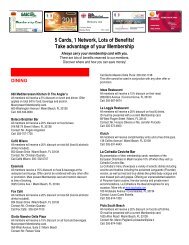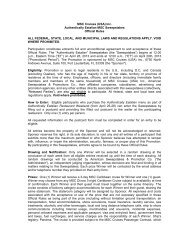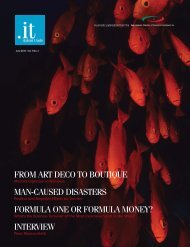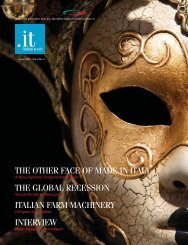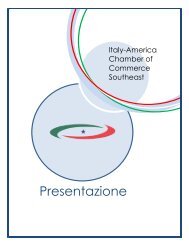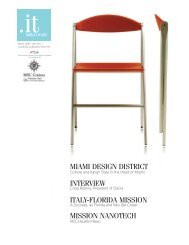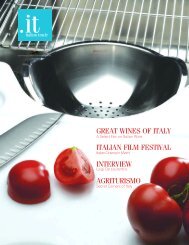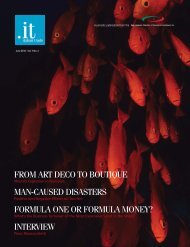italian fashion defines luxury - Italy-America Chamber of Commerce ...
italian fashion defines luxury - Italy-America Chamber of Commerce ...
italian fashion defines luxury - Italy-America Chamber of Commerce ...
Create successful ePaper yourself
Turn your PDF publications into a flip-book with our unique Google optimized e-Paper software.
and run small and medium sized companies. These types <strong>of</strong> companies, more<br />
than others, are able to keep strong on genuine and authentic values which reflect<br />
upon the final product. This has been the model under which some <strong>of</strong> the most<br />
important <strong>fashion</strong> houses such as Valentino, Versace, Armani and Cuccinelli have<br />
been born, where the idea <strong>of</strong> a family working together adds a special touch to<br />
the business and keeps the business true to authentic values and in turn connects<br />
this idea with the stylists’ image.<br />
Today, in cities such as New York, Paris and Milano, names like Gucci, Prada,<br />
Ferragamo, Bulgari, Blumarine, Cavalli and Dolce & Gabbana to name a few, are<br />
the pillars <strong>of</strong> the Italian and in many ways, the international <strong>fashion</strong> scene.<br />
In reality, <strong>fashion</strong> is nothing more than a living and evolving expression <strong>of</strong> the men<br />
and women that create it and wear it. It is as much a way <strong>of</strong> communicating<br />
as the Italian language itself. This language and this expression can only be<br />
achieved through a tradition <strong>of</strong> seduction and refinement handed down through<br />
generations. In the end, Italian <strong>fashion</strong> is not about the clothes at all, it is actually<br />
about an attitude <strong>of</strong> custom-made fluid sophistication, savoir faire and a certain<br />
nonchalance that can only be Made in <strong>Italy</strong>.<br />
Circa 1540, Caterina de Medici (1519-1589)<br />
un’azienda dei valori ed una condotta genuini ed autentici,<br />
che andranno tutti a riflettersi sul prodotto finale. Questa è<br />
stata anche la matrice da cui sono nate tutte le pi ù importanti<br />
case di alta moda, come Valentino, Versace, Armani o Cucinelli,<br />
dove la gestione familiare ben si sposa con la fortissima<br />
componente personale contenuta in questo particolare tipo di<br />
business, dove il brand è inscindibilmente legato al nome ed<br />
all’immagine dello stilista.<br />
Al giorno d’oggi, in città come New York, Parigi e Milano, nomi<br />
quali Gucci, Prada, Ferragamo, Bulgari, Blumarine, Cavalli e<br />
Dolce & Gabbana, per nominarne solo alcuni, rappresentano<br />
i pilastri della moda <strong>italian</strong>a e, per molti aspetti, anche di<br />
quella internazionale. Tutta questa visibilità e fama altro non<br />
sono che il frutto di una tradizione di seduzione e raffinatezza<br />
tramandate per generazioni, e riconosciute nel tempo a livello<br />
mondiale.<br />
In ultima istanza, la moda altro non è che un’espressione<br />
vivente e mutuante degli uomini e donne che la creano e la<br />
indossano. Essa rappresenta uno strumento di comunicazione<br />
tanto potente quanto la stessa lingua Italiana, espressivo di<br />
tradizione, significati e personalità. In altre parole, la moda<br />
<strong>italian</strong>a non si rispecchia tanto nel vestito in se, quanto in<br />
un atteggiamento complessivo s<strong>of</strong>isticato e fluido, ed in un<br />
savoir faire e nonchalance nell’indossare, che possono solo ed<br />
esclusivamente essere Made in <strong>Italy</strong>.<br />
Ancient Etruscan art<br />
.37



